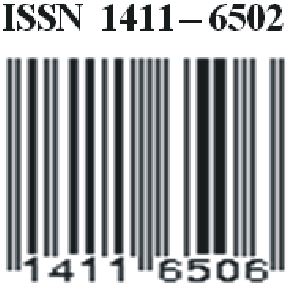Pengaruh Konsentrasi HCl Terhadap Kadar Etanol pada Fermentasi Tepung Sagu (Metroxylon sagu)
(1) Jurusan Kimia FMIPA UNM Makassar
(2) Alumni Jurusan Kimia FMIPA UNM makassar
(*) Corresponding Author
DOI: https://doi.org/10.35580/chemica.v10i2.431
Abstract
ABSTRAK
Palem Sagu mengandung karbohidrat berupa sagu (pati) dan serat yang merupakan karbohidrat potensial sebagai substrat fermentasi alkohol, asam laktat dan lain-lain. Pati sagu memiliki kadar karbohidrat 94 %. Hasil hidrolisis berupa hidrolisat yang mengandung gula pereduksi akan mudah difermentasi menjadi etanol. Penelitian ini melibatkan tepung sagu sebanyak 50 g telah dihidrolisis menggunakan asam klorida yang dipanaskan pada suhu 120oC. HCl yang digunakan adalah HCl 1 M, 2 M, 3 M ,4 M, dan 5 M yang diulang 3 kali. Hasil hidrolisis difermentasi dengan ragi roti selama tiga hari dan kadar etanolnya diukur dengan menggunakan piknometer dan dicocokkan pada tabel bobot jenis Data yang diperoleh dari penelitian ini dianalisis dengan statistik deskriptif dan inferensial. Untuk menguji hipotesis penelitian, digunakan uji F pada taraf signifikansi α = 0,05 yang dilanjutkan uji beda nyata terkecil (BNT). Hidrolisis tepung sagu menjadi gula pereduksi yang optimum didapatkan dengan HCl 4M dengan rata-rata kadar eatanol 7,47% sedangkan kadar etanol terendah dihasilkan pana konsentrasi HCl 1M dengan rata-rata kadar etanol 4,20%. Konsentrasi asam klorida berpengaruh secara signifikan terhadap kadar etanol yang dihasilkan.
Kata Kunci: sagu (metroxylon sagu), hidrolisis, fermentasi, etanol
ABSTRACT
Sago palm is included a plant of palma Family having bark cointains carbohidrate such as Sago (amylum) and fiber. Sago and fiber are the potential carbohydrate as fermentation subtract of alcohol, lactate acid, etc, those are so cheap and easy found. The amylum of sago has 94% carbohydrate content. The high carbohydrate content indicates that the amylum of sago can be prepared as the raw material of ethanol trough acid hydrolysis and fermentation process. This research involves 50 g powder of sago chemically by using chloride acid with heating at 120 oC temperature. HCl that has been used are HCl 1 M, 2 M, 3 M, 4 M, and 5 M by three times repeated. The hydrolysis result was fermentated by bread jeast and the ethanol content was measured by pycnometer that was sautéed to the specific weight table. Data was analyzed descriptively and inferentially and for testing the hypothesis is used F test on significant level, α=0,05 then continued to the smallest differentiated significant test. The optimum hydrolysis of sago powder to be reductor sugar was on HCl 4 M with the 7.4% average of ethanol, while the lowest is result on HCl 1M with the 4.2% average of ethanol. The chloride acid concentration is significantly effected of the production of ethanol.
Key Words: Sago (Metroxylon sago), hydrolysis, fermentation, ethanolFull Text:
PDFArticle Metrics
Abstract view : 1663 times | PDF view : 229 timesRefbacks
- There are currently no refbacks.
ISSN: 2722-8649
Diterbitkan oleh Jurusan Kimia FMIPA Universitas Negeri Makassar (UNM) dua kali dalam setahun yaitu bulan Juni dan Desember.
Alamat Redaksi :Jurusan Kimia, Fakultas MIPA UNM, JL. Dg. Tata Parangtambung, Makassar 90224 Indonesia, Telp. 0411-840295; Fax: 0411840295;E-mail : chemica@unm.ac.id




